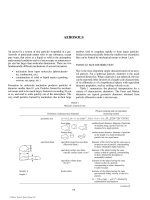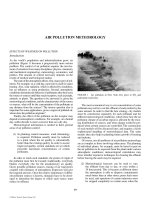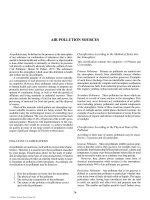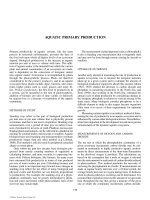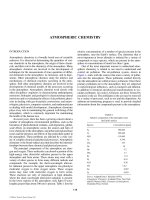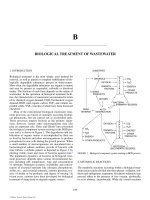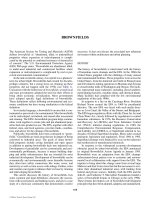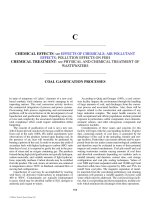ENCYCLOPEDIA OF ENVIRONMENTAL SCIENCE AND ENGINEERING - POLLUTION FROM MINE DRAINAGE docx
Bạn đang xem bản rút gọn của tài liệu. Xem và tải ngay bản đầy đủ của tài liệu tại đây (499.66 KB, 6 trang )
1016
POLLUTION FROM MINE DRAINAGE
INTRODUCTION
All forms of mining cause some impact on the aquatic envi-
ronment, just as any other earth disturbance will impact the
local hydrology. Sometimes this impact is very adverse, in
which case there is usually a considerable disruption of the
natural life cycles in the affected water. Other, and less noted
cases may even improve the local waters. Unfortunately, the
adverse impacts greatly outnumber the advantageous cir-
cumstances so that the result of mining is to severely degrade
the aquatic environment.
A generalized characterization of the impact of mining
on water is rather difficult, as almost any specific change in
the chemical qualities of the affected waters may be found
at some specific point. In almost all cases, however, there is
an increase in the total dissolved solids in the mine drain-
age waters. Additionally, the acidity of mine drainage is
increased above normal ground water levels for the area,
and the level of dissolved metal is increased. In some areas,
however, the alkalinity levels are increased by mining. Many
forms of mining also increase the suspended solids content
of water.
Coal mining has received the greatest amount of atten-
tion as the mining which causes water pollution. This is
perhaps deserved as the mining of coal has been a major
operation for many years and more coal has been mined
than any other single mineral. Water pollution from coal
mining was known in medieval England and the mines in
Wales were known to make the creeks run red. This fact
was important to the exploration of the North American
continent, as early explorers deduced the presence of large
deposits of coal from the natural color and character of some
of the streams and creeks. Similar conditions were some-
times noted in relation to other mineral deposits in the US.
As the outcrop materials come into contact with the atmo-
spheric conditions, oxidation and solubilization take place
and the products are transported into the streams. Hence,
the natural production of some mine drainage is a natural
phenomena which has existed almost from the beginning
of time.
Coal mine drainage may vary from waters pure enough
to drink without treatment to waters containing more than
20,000 mg/l acidity with commensurate amounts of iron and
other dissolved solids. Drainage from metal mines may vary
over almost equally wide ranges of acidity but often con-
tain substantial amounts of dissolved heavy metals. In most
respects the acid drainages from metal mines are similar
to acid coal mine drainages. This similarity is so great that
most of the treatment processes and prevention mechanisms
developed and applicable to coal mine drainage can also be
applied to metal mine drainage.
ORIGIN OF ACID MINE DRAINAGE
The earth strata associated with and superjacent to coal and
many other minerals almost always contain the iron sul-
fide mineral pyrite (FeS
2
). Oxidation of the acidforming
pyritic material associated with mining is necessary for the
formation of mine acids and as oxygen is a necessary part
of the oxidation of these materials, there can be no signifi-
cant amount of oxidation until these are exposed to air. The
process of mining greatly increases the exposure of these
materials to atmospheric oxidation. Oxidation of the sulfide
mineral begins as soon as it is exposed to the air and contin-
ues at a rate characteristic of the geologic and atmospheric
conditions. Usually this oxidation causes spalling of the
mineral substance with a progressive increase in the amount
of surface area available for oxidation. Time then becomes a
significant factor in the amount and rate of formation of acid
mine drainage.
The exact nature of the pyritic mineral which oxidizes
so rapidly and causes the acid drainage from mining has
been sought for many years. In appearance, the mineral
is often grey like marcasite, and its oxidation rate is even
more rapid than that of marcasite. X-ray diffraction stud-
ies of the sulfide material associated with coal, however,
have confirmed by the crystal structure that the material
is pyrite rather than some other crystalline form of iron
sulfide.
The intricate mechanism of oxidation of this pyrite and
the formation of acid drainage has been the subject of many
learned discussions and research efforts extending back over
fifty years or so. The reaction will occur at normal room
temperature and humidity conditions with the release of SO
2
into the atmosphere. Under more humid conditions, the reac-
tion results in all of the sulfur being converted into sulfate.
Typical reactions depicting some of the several paths pos-
sible for the reaction of the iron sulfide, air, water and alkali
materials are listed.
This list is typical rather than all-inclusive to cover all
possible reaction routes.
C016_010_r03.indd 1016C016_010_r03.indd 1016 11/18/2005 11:03:03 AM11/18/2005 11:03:03 AM
© 2006 by Taylor & Francis Group, LLC
POLLUTION FROM MINE DRAINAGE 1017
FeS 3O FeSO SO
2FeS 7O 2H O 2FeSO 2H SO
4FeSO 2H S
22 4 2
222 424
42
ϩϩ
ϩϩ ϩ
ϩ
→
→
OO O 2Fe (SO ) 2H O
4FeSO O 2H O 4Fe(OH)SO
Fe (SO )
42 243 2
42 2 4
24
ϩϩ
ϩϩ
→↓
→↓
332 4 24
22 4 4 32
2H O 2Fe(OH)SO H SO
Ca(HCO ) FeSO CaSO Fe(HCO )
4
ϩϩ
ϩϩ
→↓
→
FFe(HCO ) O 2H O 4Fe(OH) 8CO
Ca(HCO ) Fe (SO ) 4H
22 2 2 3 2
22 2 43
ϩϩ ϩ
ϩϩ
→↓↑
22
43224
22 2 4 4
O
CaSO 2Fe(OH) 2CO 2H SO
Ca(HCO ) H SO CaSO 2CO
→
↓↑
→
ϩϩϩ
ϩϩ
222
2H O.↑ϩ
There has been a continuing debate among the scientific
community over the role which bacteria may play in the for-
mation of acid mine damage. Bacteria of the Ferrobacillus
ferroxidans family are almost always found in large pools of
acid mine drainage. The bacteria have been shown to have
the capability of oxidizing ferrous iron to the ferric state.
However, they thrive in a very limited pH range (approxi-
mately pH 3.5) and there is no evidence to indicate that they
contribute directly to the primary oxidation of the pyretic
substance. Ferric ion can oxidize sulfide sulfur and this could
possibly provide a mechanism for the bacteria to increase
the rate of oxidation of pyrite in some circumstances. Other
recent studies have shown that the transfer of oxygen from
the atmosphere to the pyrite surface is the rate limiting
factor of the reaction, making moot arguments put forth as
to whether bacterial or chemical oxidation is the principal
mechanism of acid drainage formation.
Bacteria may play a significant role in the oxidation of
the ferrous to ferric ion in mine drainage. This fact can be of
considerable importance in the treatment of mine drainage
as ferrous iron tends to retard the rate of neutralization reac-
tions. It almost appears that this is Nature’s first step in the
neutralization of acid drainage. The bacterial oxidization of
iron allows the alkalinity of the associated earth strata and
of diluting waters to be more readily reacted with the acid-
ity of the mine drainage waters. This concept is rather radi-
cally at variance with former concepts that considered the
sterilization of a mine as a possible method of reducing or
eliminating the formation of acid drainage. Bacteria has been
used deliberately as a step in the treatment of mine drain-
age. This process allows the ferrous iron to be oxidized and
accelerate the neutralization of the acid salts.
The formation of acid drainages from surface and under-
ground mines is essentially the same process, and the two
drainages are indistinguishable on the basis of the chemi-
cal qualities of the waters. In general the iron contained in
drainage from surface mines and also from coal refuse piles
is in the ferric state. The drainage from surface mining may
contain very substantial amounts of suspended solids or sedi-
ment. Because many of the drainage problems of strip and
deep mines are directly interrelated there is almost no rational
way of separating the treatment or preventive measures which
may be applied to the two types of mining.
EXTENT OF ENVIRONMENTAL IMPACT
The problem of environmental degradation caused by mine
drainage is widespread and serious. Some form of mining
occurs in each of the fifty states and many states are exten-
sively mined. The aquatic degradation caused by coal mining
in the eastern and Appalachian region is best known and has
been best documented. For this reason, most statements of
the damages caused by mine drainage cite only the degra-
dation in the Appalachian area. The Appalachian Regional
Commission reported that some 10,500 miles of streams in
that region are affected by mine drainage and acid drainage
continually pollutes nearly 5700 stream miles. Since data
are not available in many mining areas, particularly in the
Rocky Mountain and western areas, firm total statements of
the extent of the problem cannot be made. However, enough
information is available to indicate that it is very substantial.
The extent and amount of degradation which may be
caused by the presence of mine drainage, and the environ-
mental and economic impacts which may be felt, vary, of
course, with the type of mine, the strata surrounding it, and
other localized conditions.
For example, coal mine drainage, which is usually acidic,
kills fish and other forms of aquatic biota by lowering the pH
of the water and also may have an adverse economic effect
upon the human population. The acidity accelerates the cor-
rosion of bridges, culverts, boats and navigational facilities,
making replacement at shorter intervals necessary. High cost
water treatment may be required to make the local water
supply potable or suitable for industrial use. Water contact
sports may not be possible in the area, causing a loss of
potential tourist industry revenues.
Although metal mining may cause the same adverse
effects, it usually occurs in less densely populated regions.
Additionally, metal mine drainage may render the waters
toxic to humans as well as aquatic life by the presence of
heavy metals.
REMEDIES FOR MINE DRAINAGE POLLUTION
In the past a substantial number of investigators have simply
discussed the problem and observed its extent so that more is
known about the nature of the problem than about the mech-
anisms which may be applicable to correcting or mitigating
it. Mine drainage may be characterized on the basis of its
source and possible remedies considered by this categoriza-
tion even though the chemical nature and biological impact
of the drainage from the several sources is identical. For the
purposes of this discussion let us consider three types of
mine drainage by the source: drainage from active or operat-
ing mines, drainage from non-operating (sometimes called
abandoned) mines and drainage which will be generated in
the future from mines which have not yet begun operation.
C016_010_r03.indd 1017C016_010_r03.indd 1017 11/18/2005 11:03:04 AM11/18/2005 11:03:04 AM
© 2006 by Taylor & Francis Group, LLC
1018 POLLUTION FROM MINE DRAINAGE
Separating surface and underground mines is not feasible
as they frequently occur together and interact to add to the
problem.
Presently operating mines have certain characteristics
which differentiate mines them from other mines. Primarily
because they are now in operation a responsible owner or
operator can be located and people, equipment, machinery
and power are available at the mine site. This allows con-
sideration of procedures to treat the mine drainage as well
as procedures to reduce or minimize the amount of pollut-
ants discharged both during the remainder of the mine’s
life and after mining has been terminated. Procedures pres-
ently available may be employed to minimize the amount
of mine drainage pollution which issues from an operat-
ing mine, but no procedures are now available which can
totally eliminate it.
Non-operating, or abandoned mines, generally do not
have any responsible person readily available, or any other
resources such as personnel and machinery, which makes
abatement techniques more expensive for this type of mine
than for one which is operating.
When a mine is still in the planning stage, it is easier
to plan for future prevention of pollution and thereby reduce
it. For instance, provisions can be pre-planned for a mine to
have rapid and complete drainage during the mining opera-
tion, thereby reducing the pollutional discharges which other-
wise may need to be treated. Additionally, improved mining
methods can provide for minimum void spaces after mining;
also water level control after mining ceases can be provided
only during the mine pre-planning stages.
The methods for alleviating mine drainage may be
divided into the two basic categories of treatment of mine
drainage, and prevention of the formation of discharge of
pollutants.
Treatment removes pollutants by physical/chemical
means and generally results in only specific pollutants being
removed or reduced. The process must continue for as long
as the source produces pollution and usually in the case of
mine damage this is tantamount to “treatment in perpetuity.”
Disposal of wastes and constant usage of power or chemicals
made such treatment unduly consumptive of both human and
physical resources. Treatment methods for coal mine drain-
age are summarized in Table 1 and many of the methods are
applicable to other types of mine drainage pollution.
Prevention is the total cessation or massive reduction of
the formation or discharge of pollutants during and after the
operating life of the mine. Prevention of all forms of pollution,
including dissolved and suspended materials, is obviously more
desirable than simple treatment of pollution with its attendant
problems. Provisions for prevention of the formation of pollu-
tion cab be planned into a mine while it is still on the drawing
board. Specific techniques for prevention and correction of
pollution from mines, both operating and non-operating, are
shown in Table 2.
TABLE 1
Summary of treatment techniques
Pollutants removed
a
Neutralization and
aeration
Microbial iron
oxidation
Reverse
osmosis Ion exchange Flash distillation
d
Electro-dialysis
Product
recovery Silt basins
Acidity
XXX NA XX X
c
XX X
e
X
f
NA
Iron XX XX XXX X
c
XXX ? X
f
NA
Aluminum XXX NA XXX X
c
XXX X
e
X
f
NA
Manganese X
b
NA XXX X
c
XXX X
e
X
f
NA
Copper XX NA XXX X
c
XXX X
e
X
f
NA
Zinc X
b
NA XXX X
c
XXX X
e
X
f
NA
Hardness — NA XXX X
c
XXX X
e
X
f
NA
Suspended solids X NA NA NA NA NA X
f
X
Dissolved solids — NA XXX X
c
XXX X
e
X
f
NA
State of art
g
CU PP PP R, PP, FSO
c
FSD R
e
R R, CU
Cost, $/1000
h
0.05–4.55 UK 0.30–2.57 0.30–2.53 0.33–3.25 0.52–2.52 UK 0.02–1.0
Waste product
j
S S B B, R B B S,B,R S
a
NA—Not applicable, ? Questionable, X-degree to which removed, the greater number of “X”s the higher the removal.
b
Must be raised to very high pH.
c
Various ion exchange techniques are under evaluation. Their effectiveness and which pollutant is removed depends on the technique.
d
5 mgd plant is under construction in Pennsylvania. Techniques has only a limited potential.
e
Technique will not operate where iron is present in water.
f
Various product recovery schemes are under consideration; however, all are still in research stage.
g
R—Research, PP—Pilot Plant, FSD—Full Scale Demonstration, CU—Common Usage.
h
Cost depends on the degree of pollution, size of plant, pre- and post-treatment requirements. UK—Unknown.
j
Each treatment process has a waste product that must be disposed of and creates additional problem. S—insert sludge, B—highly mineralized brine,
R—regenerate.
C016_010_r03.indd 1018C016_010_r03.indd 1018 11/18/2005 11:03:04 AM11/18/2005 11:03:04 AM
© 2006 by Taylor & Francis Group, LLC
POLLUTION FROM MINE DRAINAGE 1019
TABLE 2
Cost and effectiveness of various at-source prevention and corrective techniques
Control techniques
Effectiveness %
Cost Remarks
Surface mine reclamation
25–90 $300–3000/acre Includes backfilling, regarding, contouring, and water control
structures. Prevents acid formation, erosion control, runoff of
dissolved soils. Cost and effectiveness controlling factors are nature
of surface and overburden, slope of land, and proposed use of land.
Mine sealing (air) 0–50 $1000–5000/seal. Additional
cost of $5000–100,000/seal
may be required to control
entrance of air through
subsidence holes,
boreholes, outcrop, etc.
Sealing of an underground mine to prevent entrance of air. Prevents
acid formation. Cost of effectiveness depend on the ability to locate
and seal all air paths to the mine, type and condition of mine
operating and type of seal. Most mines cannot be airsealed.
Mine sealing (flooding) 75–99 $1000–20,000/seal.
Additional costs of $5000–
20,000 may be required to
control drainage through
bore holes, outcrop, etc.
Sealing of an underground mine to completely and permanently flood
the working. Prevents acid formation and sometimes all discharges.
Cost and effectiveness depend on the ability to seal all discharges,
size of mine, dip of seam, outcrop condition, condition of mine
opening, type of seal, and amount of grouting required. Is not
applicable to all mines.
Drainage diversion 25–75 $200–20,000/acre The prevention of water from entering the mine area. Prevention of
siltation and flushing of pollutants. Cost and effectiveness depend on
ability to divert as much water as possible in properly designed
structures.
Impoundment 50–95 $350–1000/acre-ft Flooding of surface mine pits. Prevents acid production. Cost and
effectiveness depend on complete and permanent flooding of the
material responsible for acid production.
Refuse pile reclamation
(reject material from
mining and processing)
25–75 $1000–3000/acre Stabilizing a refuse pile with soil, chemicals, vegetation, etc. Prevents
acid production and siltation. Cost and effectiveness depend upon
the availability of the land in which the refuse piles can be filled and
also upon the availability of impervious materials such as clay, fly
ash, or limestone for compaction over the surface of the filled area.
Reject tailing pond (reject
material from mining
and processing in slurry
form)
25–95 $300–2000/acre Stabilizing of tailings by flooding, soil covering, chemicals, vegetation,
etc. Prevents air pollution and discharge of suspended and dissolved
solids. Cost and effectiveness depend upon the size, location.
Revegetation 5–25 $70–700/acre Establishment of vegetative cover on reclaimed surface mines, reject
piles, and pond. Prevents erosion. Cost and effectiveness depend on
the type of cover, soil conditioning, and thickness of cover required.
Controlled pumping and
drainage
25–75 $0.190.23/1000 gallon Involves rapid removal of water from a mine before it gets
contaminated or discharge of contaminated water at regulated rate so
that dilution provides minimum contamination effects. Cost and
effectiveness depend upon the characteristics of the material in the
mine, contact time between water and exposed materials, rate of
pumping, pumping head, and amount of dilution water available.
Inert gas blanket Under research and development Filling of an underground mine with an inert gas to prevent acid
production. Control of the bacteria in a mining environment.
Prevents acid production. Technique does not show merit at this
time.
Sterilization Under research
Internal sealing Under research and development Internal sealing of underground mine to prevent acid production and/or
mine drainage discharge.
Longwall mining Under research and development Allows complete removal of the coal in an underground mine. Mine
roof collapses behind the working face, eliminating “breathing” of
the mine.
Daylighting Under research and development Strip mining of a previously mined underground seam. Removes pillars
left before. Surface must be reclaimed.
C016_010_r03.indd 1019C016_010_r03.indd 1019 11/18/2005 11:03:04 AM11/18/2005 11:03:04 AM
© 2006 by Taylor & Francis Group, LLC
1020 POLLUTION FROM MINE DRAINAGE
It can be seen from Table 2 and Figure 1 that the cost of
creating or preventing the formation of mine drainage is a
wide ranging variable, dependent on the method(s) selected
for use. The estimated costs for the limestone neutralization
treatment of mine drainage are shown in Figure 1 as a func-
tion of acidity and quantity to be treated.
As can be seen in the figures, the number of methods of
alleviation and control of mine drainage which are highly
effective are few, and most treatment processes produce
undesirable by-products, as well as being expensive over the
long run. It would be highly desirable to lessen the sources
of mine drainage and to be able to treat it effectively with a
gain in desirable by-products.
New techniques for the prevention of pollution from
mines are presently in the development and demonstration
stage. For example, a new technique known as “daylight-
ing” is being demonstrated. This procedure will use strip
mining techniques to remove the residual coal from shal-
low, non-operating mines and consolidate the overburden to
prevent the continued discharge of acid drainage. A variety
of abatement techniques related to surface mine reclama-
tion are being demonstrated in the Appalachia region. Also
there are two major efforts directed toward the development
of non-pollutional mining techniques. These are the mining
of coal under oxygen free conditions within the mine to
1 2 3 4 5 6 7 8 9 101112131415
$1.00
.90
.80
.70
.60
.50
.40
.30
.20
.10
.09
.08
.07
.06
COST PER 1000 gal.
ESTIMATED LIME NEUTRALIZATION TREATMENT COST - COAL MINE DRAINAGE
O.I MGD
1 MGD
2–4 MGD
6–7 MGD
FIGURE 1 Estimated costs for treatment of coal mine drainage waters based upon a composite
of published laboratory, pilot plant, and actual plant data. The estimate for the 0.1 MGD plant is
preliminary and based upon limited information.
prevent the oxidation of pyrite and the formation of acid
drainage and the application of a new mining technique
called “longwall stripping.” Longwall stripping will apply
longwall mining techniques to shallow cover coals, which
are now strip mined, to remove the coal without inverting or
dismantling the overlying earth strata.
LITERATURE REFERENCES
Most discussions of this type are buttressed by an impressive
listing of reference documents citing sources of the many facts
contained therein. To the casual reader, these references are
useless, except for their creation of an impression of author-
ity. The serious worker will demand to have even more refer-
ences and documentation. The field of coal mine drainage is
somewhat unique in that the literature of the field is regularly
collected, abstracted and these abstracts published. This pub-
lication, entitled “Mine Drainage Abstracts, a Bibliography”
is prepared by the Bituminous Coal Research, Inc. for the
Commonwealth of Pennsylvania. Copies may be purchased
from B.C.R., Monroeville, Pennsylvania. A listing of the
reports of the research in this field may be obtained from
the Publications Branch, Office of Research and Monitoring,
Environmental Protection Agency, Washington, DC 20460.
C016_010_r03.indd 1020C016_010_r03.indd 1020 11/18/2005 11:03:04 AM11/18/2005 11:03:04 AM
© 2006 by Taylor & Francis Group, LLC
POLLUTION FROM MINE DRAINAGE 1021
REFERENCES
1. Ramsey, D.L. and D.G. Brannon, Predicted Acid Mine Drainage
Impacts to the Buckhannon River, West Virginia, Water, Air and Soil
Pollution, 39, 1, 1988.
2. Sobek, A.A., M.A. Bambenck, and D. Meyer, Soil Sci. Soc. Am. J., 46,
1982.
3. Sullivan, P.J., S.V. Mattigo, and A.A. Sobek, Dissociation of Iron
Sulfates from Pyritic Coal Wastes, Environ. Sci. Tech., 20, 10, 1986.
ERNST P. HALL
Environmental Protection Agency
POLLUTION LAW: see ENVIRONMENTAL LAW
POLLUTION METEOROLOGY: see AIR POLLUTION METEOROLOGY
POLLUTION OF GROUNDWATER: see GROUND WATER RESOURCE
PRIMARY TERRESTRIAL CONSUMERS: see ECOLOGY OF PRIMARY
TERRESTRIAL CONSUMERS
PROTECTION OF THE ENVIRONMENT: see ENVIRONMENTAL LAW
C016_010_r03.indd 1021C016_010_r03.indd 1021 11/18/2005 11:03:05 AM11/18/2005 11:03:05 AM
© 2006 by Taylor & Francis Group, LLC

